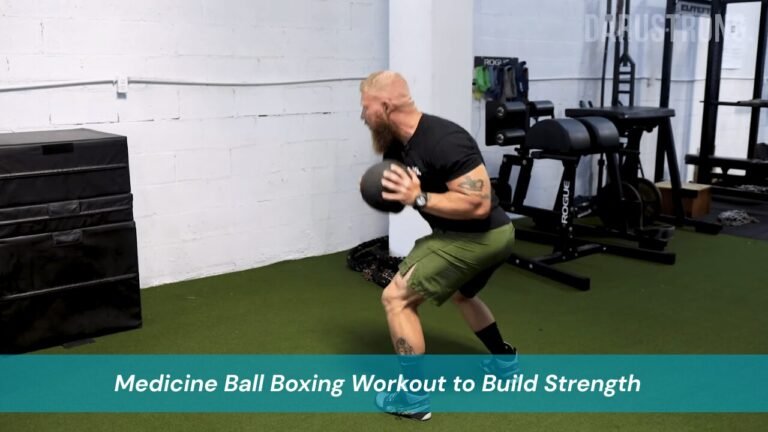If you’ve ever watched professional boxers train, you know their routines go far beyond simply throwing punches. Behind every fast jab, powerful hook, and relentless pace in the ring is a carefully structured training plan that blends skill, conditioning, and strength. A boxer workout plan is not only for fighters preparing for competition; it is also an excellent program for anyone who wants to get lean, strong, and fit while building mental toughness.
This complete plan is designed to give you the same foundation professional fighters rely on. Whether you are a beginner looking to train like a boxer or an intermediate athlete aiming to sharpen your skills, this program will help you punch harder, move faster, and develop the stamina to outlast any opponent or any workout challenge.
Who This Is For and What You’ll Gain
A boxer workout plan is suitable for multiple types of athletes. Fitness enthusiasts who want to break free from boring gym routines will find boxing-style workouts refreshing and challenging. Amateur boxers or those who practice combat sports can use this plan to develop core skills that directly transfer to performance in the ring. Even individuals looking for weight loss and full-body conditioning can benefit, since boxing training burns high calories while simultaneously building muscle and endurance.
The benefits extend far beyond physical appearance. You’ll build speed, agility, and explosive strength. Your cardiovascular conditioning will improve dramatically, allowing you to perform at high intensity without gassing out. Footwork and coordination drills will sharpen your reflexes, while mobility and recovery work will protect your joints. Perhaps most importantly, the mental discipline of boxing will carry over into other areas of your life, improving resilience and focus.
How the Plan Works
The structure of this program is simple but highly effective. It revolves around four key pillars. The first is technical skill training, which includes shadowboxing, jump rope, heavy bag drills, mitt work, and footwork practice. This sharpens technique while reinforcing muscle memory. The second pillar is strength and power training, built around compound lifts, explosive movements, and stabilizing exercises. This ensures that every punch carries force and that the body can withstand the demands of long training sessions.
The third pillar is conditioning work, which develops fight-ready endurance. This includes interval training, tempo runs, and high-intensity bag circuits designed to mimic the demands of a real fight. The fourth and final pillar is recovery, which often gets neglected but is essential for long-term progress. Proper sleep, nutrition, mobility drills, and smart rest days are what allow the body to adapt and grow stronger week after week.
Weekly Training Structure
This plan runs on a five-day training schedule with two lighter recovery days. Monday is dedicated to technical drills and lower-body strength training. Tuesday emphasizes conditioning and core stability. Wednesday is reserved for skills-only sessions with extra time devoted to technique and footwork. Thursday focuses on upper-body and rotational power. Friday brings another conditioning session, either through running or intense bag work. Saturday is for active recovery such as stretching, mobility work, and light shadowboxing, while Sunday is for complete rest.
If you are a beginner, you can start with four training days by skipping Wednesday’s skills-only session and adding it in later once your recovery improves. Intermediate athletes or those with boxing experience should commit to the full five-day routine for maximum benefit.
Warm-Up and Mobility
Every great workout begins with a proper warm-up. In boxing, the body must be primed for explosive movements and quick reactions. Begin each session with three minutes of jump rope, alternating between light bouncing and fast-paced turns. Dynamic mobility follows, including hip circles, leg swings, and torso twists to loosen up the lower back and hips. Shoulders should be prepared with movements such as band pull-aparts and scapular push-ups. Finish with short primers like high knees, lateral shuffles, and arm circles to raise your heart rate and prepare the nervous system for sharp movement.
Technical Boxing Drills
The heart of the boxer workout plan lies in skill work. Shadowboxing is a must, performed for three to five rounds of two to three minutes each. Start by focusing on stance and guard, then progress to jab variations and head movement. Later rounds should incorporate combinations, pivots, and defensive counters such as slipping and rolling. Shadowboxing is not just about throwing punches it’s about visualizing an opponent, refining form, and building rhythm.
Heavy bag work is the next step. Aim for three to six rounds, starting with light jabs and feints before moving into combinations and power shots. Midway through, incorporate hooks and uppercuts, mixing body and head punches. The final rounds should push conditioning with higher intensity, but always prioritize technique over raw speed.
Footwork drills complete the technical portion. Practice stepping in and out with V-steps, changing angles with L-steps, and circling around an imaginary opponent in both directions. These drills improve agility and positioning, allowing you to control the ring. If you have access, the speed bag is excellent for rhythm and shoulder endurance, adding two to three rounds of extra skill work.
Strength and Power Training
Boxers need both strength and speed, which is why the lifting program focuses on power-oriented movements. Monday emphasizes lower-body power with squats or trap bar deadlifts performed for low reps and heavy weight. Bulgarian split squats build single-leg stability, while kettlebell swings enhance hip explosiveness. Quick ankle jumps train elasticity for faster footwork.
Thursday shifts focus to upper-body and rotational strength. Bench presses or dumbbell floor presses develop pushing power, while medicine ball rotational throws mimic the twisting motion of a punch. One-arm rows strengthen the back and prevent muscular imbalances. Shoulder prehab, such as face pulls and external rotations, protects the joints. Landmine presses add rotational force, and short conditioning finishers like battle ropes simulate the burn of late-round exchanges.
The emphasis in both strength sessions is quality over quantity. Reps should be controlled, with maximal effort applied on the explosive phase of each lift. This ensures strength transfers directly into punching power.
Conditioning and Roadwork
No boxer workout plan would be complete without conditioning. Boxing requires the ability to push hard for multiple rounds without fading. Tuesday’s session focuses on high-intensity intervals such as eight to ten rounds of 30 seconds of maximum effort followed by one minute of light recovery. This can be done on a track, stationary bike, or rower.
Friday offers two options. The first is a tempo run of 15 to 20 minutes at a steady, conversational pace. This builds aerobic endurance and aids recovery. The second option is bag conditioning, where you perform ten one-minute rounds with 30 seconds rest. Early rounds emphasize form, while later rounds gradually increase speed and power, simulating the intensity of a fight.
Core and Injury Prevention
Boxers generate power from the core, making this section non-negotiable. Core stability should be trained three to four times per week with exercises such as Pallof presses, hollow holds, side planks, and loaded carries. These build anti-rotational strength and protect the spine during explosive movements. Adding shoulder-prehab drills like YTWs and band rotations will reduce injury risk and allow for higher training volumes.
Sample 60-Minute Session
A well-rounded session begins with ten minutes of mobility and warm-up. This is followed by shadowboxing for four rounds and heavy bag work for another four rounds. A footwork circuit lasting around six minutes reinforces movement, and a short block of core training enhances stability. The session closes with stretching to encourage recovery. Within an hour, you’ll cover all the key aspects of boxing training.
Four Week Progression
This plan uses a four-week progression model to ensure continuous improvement. The first week is introductory, with fewer rounds, lighter loads, and shorter intervals. The second week increases volume slightly by adding an extra round or small weight increase. Week three is the peak, with maximum rounds, added sets, and extended conditioning. Week four is a deload where volume and intensity are reduced to allow recovery. After four weeks, the cycle restarts at a higher baseline.
The Eight-Week Framework
Over eight weeks, this program builds a solid base of boxing conditioning, technique, and strength. Monday blends skills with lower-body lifting, Tuesday focuses on conditioning and core, Wednesday is reserved for technique and mobility, Thursday emphasizes upper-body and rotational power, and Friday delivers conditioning through running or bag intervals. Saturday and Sunday are recovery-focused. After eight weeks, you’ll notice sharper technique, stronger punches, and greater endurance.
Nutrition and Recovery
Nutrition is the foundation of athletic progress. Protein intake should remain between 1.6 and 2.2 grams per kilogram of bodyweight to support muscle repair. Carbohydrates, especially around training windows, fuel performance and recovery, with foods like rice, oats, and fruits as staples. Healthy fats from fish, nuts, and olive oil ensure hormonal balance. Hydration should not be overlooked. Two to three liters of water daily is a baseline, with electrolytes added if training is intense.
Sleep is another key factor. Aim for seven to nine hours each night with consistent sleep and wake times. Active recovery, including stretching, foam rolling, and light shadowboxing, helps the body adapt to the stress of training. Many athletes neglect recovery, but it’s during this phase that real progress occurs.
Common Mistakes to Avoid
Beginners often focus too heavily on conditioning at the expense of skill. Overtraining is another common issue, as athletes push themselves with too many rounds or too much weight too quickly. Others fail to follow a progression plan, repeating the same workouts without making adjustments. Neglecting mobility, shoulder health, or pacing during bag work can also stall progress. Success comes from consistency, gradual progression, and attention to detail.
FAQs
How many days per week should I train?
Five days is ideal, though beginners can start with three to four days and gradually add sessions as their conditioning improves.
Can this plan build muscle as well as fitness?
Yes, the combination of strength training and high-volume boxing work supports lean muscle growth when paired with proper nutrition.
What if I don’t have a heavy bag?
Focus on shadowboxing, footwork, and defensive drills. You can also use resistance bands for punching power and medicine balls for rotational strength.
When should I increase intensity?
Increase rounds, sets, or weight only once you can complete all prescribed work with clean technique and controlled breathing.
Conclusion
A structured boxer workout plan is more than just a fitness program; it’s a complete approach to athletic performance, resilience, and conditioning. By combining technical drills, strength development, conditioning, and recovery, this plan prepares you not only for the demands of boxing but for the demands of life itself. Over the span of eight weeks, you’ll build sharper reflexes, faster footwork, and powerful punches, while also achieving noticeable improvements in body composition and cardiovascular fitness.
Perhaps the greatest benefit of boxing training is the mental edge it develops. The discipline of showing up to each session, pushing through fatigue, and learning to stay composed under pressure carries over into everyday challenges. You’ll develop patience, confidence, and resilience, the same traits that allow boxers to thrive in the ring.
Whether you are chasing athletic performance, weight loss, or simply a more engaging workout routine, this plan delivers results. Stay consistent, progress gradually, and remember that every round is an opportunity to improve. In eight weeks, you won’t just feel fitter you’ll feel sharper, stronger, and mentally tougher. That’s the true reward of following a well-designed boxer workout plan.




